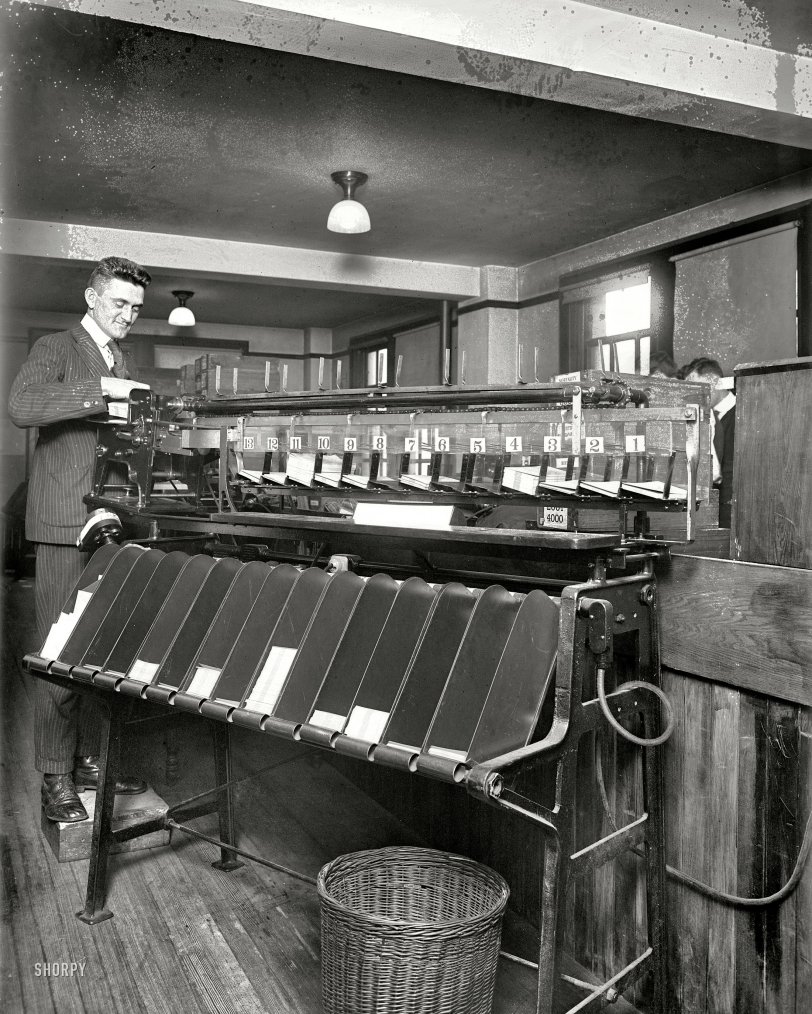


Framed or unframed, desk size to sofa size, printed by us in Arizona and Alabama since 2007. Explore now.
Shorpy is funded by you. Patreon contributors get an ad-free experience.
Learn more.

- Texas Flyer wanted
- Just a Year Too Soon
- WWII -- Replacing men with women at the railroad crossing.
- Yes, Icing
- You kids drive me nuts!
- NOT An Easy Job
- I wonder
- Just add window boxes
- Icing Platform?
- Indiana Harbor Belt abides
- Freezing haze
- Corrections (for those who care)
- C&NW at Nelson
- Fallen Flags
- A dangerous job made worse
- Water Stop
- Passenger trains have right of way over freights?
- Coal
- Never ceases to amaze me.
- Still chuggin' (in model form)
- Great shot
- Westerly Breeze
- For the men, a trapeze
- Tickled
- Sense of loneliness ...
- 2 cents
- Charm City
- What an Outrage
- Brighton Park
- Catenary Supports
Print Emporium
Fourteenth Census: 1919

December 1919. Washington, D.C. "Sorting machine, U.S. Census." Getting ready to tabulate the 1920 Census. Under-height operators will please furnish their own boxes. National Photo Company Collection glass negative. View full size.
I dropped my first tray of cards
On the tab room floor around 1965. Happens to everyone sooner or later. Interesting the cards are loaded on the left side; all the later machines were on the right side, I guess to make it easier for right handed folks.
I just saw one
There are some International card sorters at the Computer History Museum in Mountain View, California if you'd like a closer look. You won't get much more color, though, as they were available in such exciting colors as black and, later, grey.
OSHA Approved?
The last guy using the sorter wound up in the "Mortality" bin, just behind it!
Father of Spartacus
That man could easily be the father of Kirk Douglass. There is possibly a cleft chin as well. To top it off he is extending his height by standing on a box and Kirk Douglass often used lifts in his shoes to make him appear to be about 5' 11".
[More like Son of Frederick, unless you lose an S. -Dave]
Ah - right you are Dave! One S too many. Of course, his real name is Demsky anyway.
Foundation of Empire
Card sorter, invented by Herman Hollerith in the late 1800s, the machine that built the company that later became IBM. The machines for punching the cards were important, too, but it was the sorter that eliminated manual ordering and made the process more efficient.
Along the top of the machine are flexible splines made of spring material, one ending at each output bin. At the input end, there is an arrangement that determines which hole is punched, and a solenoid lifts the input end of the appropriate spline. The card goes under the spline, and when it reaches the right output bin a bend in the spline forces it through the slot. If the card isn't perfectly flat it hangs up somewhere, jamming the whole machine and probably ruining more cards. That's why the legendary admonition "do not bend, fold, spindle, staple, crush, crease, or mutilate" the cards.
The reading mechanism can only read one column at a time. In an early model like this one there's only one reader, which is moved mechanically to the column to be sorted. To sort on multiple columns, start with the least significant digit, run all the cards through, and stack them in the trays below the machine. Then move the reader to the next most significant column and do it again, starting with the pile in the least-significant column of the stacker. That was my first job in Data Processing, and occupied many hours on Saturdays and evenings.
These cards all have square corners. Clipping one corner, to make the correct orientation of the card obvious, had to wait for a later inventor. The operator had to pay close attention, so it was a skilled (and well-paid) job. Getting a card, or (worse) a partially-sorted stack, reversed or upside down meant the whole pile had to be manually re-ordered, a daunting task if there are a lot of cards.
























On Shorpy:
Today’s Top 5